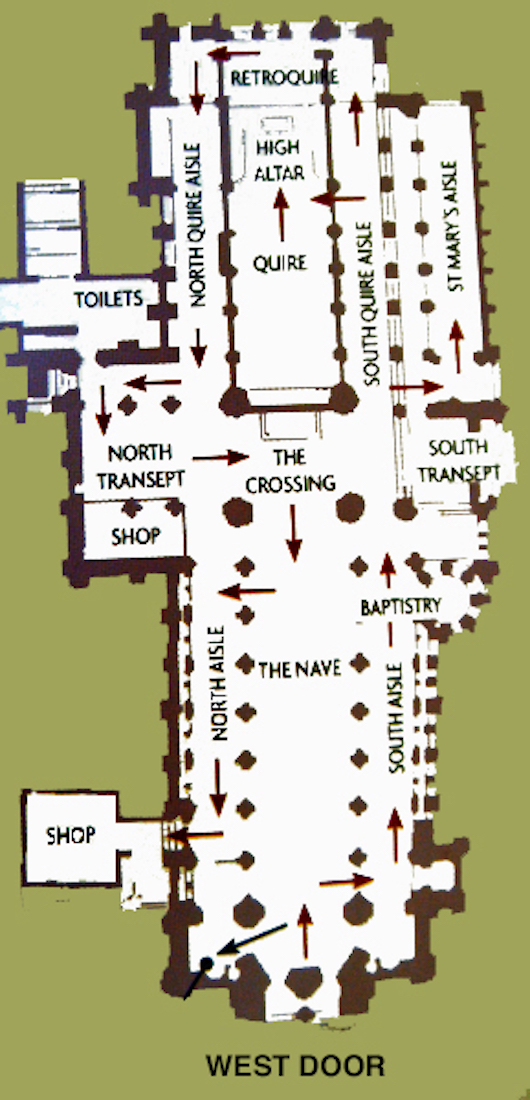TRURO CATHEDRAL
CORNWALL, ENGLAND
PAUL SCOTT

The most notable feature of the plan of Truro Cathedral is the kink at the crossing, but we shall return to this.
In our investigation of this Cathedral we shall start outside near the West door and follow around in a clockwise direction. Then entering by the West door, we roughly follow the brown arrows to the South transept, St Mary’s Chapel, the retrochoir, the North transept, back down the nave, and finishing up at the quire and sanctuary.
The Cathedral is essentially cruciform in shape, but this is obscured by the various additions. Near the North transept, a link leads off to a very nice cafeteria.
You can access intermediate points in your tour by a tap / click on the following links:
107. Sanctuary
A history of the Cathedral is given below, but if you want to start yo8 rour immediately, tap / click on START.
Or, if you wish to go straight inside the Cathedral, tap / click on Nave 21.
NOTE ON MAGNIFYING IMAGES
With this website format the images are large enough for most purposes. If there is a need for greater magnification of an image, go to the identical photo on
https://www.flickr.com/photos/paulscottinfo/albums
and use Command - + (Mac) or Windows - + (Windows).
HISTORY
[Wikipedia]
The Cathedral of the Blessed Virgin Mary, Truro is a Church of England cathedral in the city of Truro, Cornwall. It was built between 1880 and 1910 to a Gothic Revival design by John Loughborough Pearson on the site of the parish church of St Mary. It is one of only three cathedrals in the United Kingdom with three spires.
The Diocese of Truro was established in December 1876, and its first bishop, Edward White Benson, was consecrated on 25 April 1877 at St Paul’s Cathedral.
Construction began in 1880 to a design by the leading Gothic Revival architect John Loughborough Pearson. Truro was the first Anglican cathedral to be built on a new site in England since Salisbury Cathedral in 1220. It was built on the site of the 16th-century parish church of St Mary the Virgin, a building in the Perpendicular style with a spire 128 feet (39 m) tall. The final services in St Mary’s were held on Sunday 3 October 1880 and the church was demolished that month, leaving only the south aisle, which was retained to serve as the parish church. From 24 October 1880 until 1887 a temporary wooden building on an adjacent site served as the cathedral. The seats were free and unappropriated, accommodated fewer than 400 people and the building was extremely hot in summer and cold in winter. It was in this building that Benson introduced the new evening service of Nine Lessons and Carols on Christmas Eve, 1880. By October 1887 the choir and transepts were complete. The service of consecration took place on 3 November, performed by E. W. Benson, by then Archbishop of Canterbury. His successor as Bishop of Truro, George Wilkinson, and twenty other bishops were also present, together with civic representatives and diocesan clergy, and about 2,000 other people. The central tower was finished by 1905 and the building was completed with the opening of the two western towers in 1910. J. L. Pearson died in 1897 and his son Frank took over the project. Frank Loughborough Pearson’s other works include St Matthew’s, Auckland in New Zealand, a reduced version of Truro Cathedral.
Pearson’s design combines the Early English style with certain French characteristics, chiefly spires and rose windows. Its resemblance to Lincoln Cathedral is not coincidental: Pearson had been appointed as Lincoln Cathedral’s architect and the first Bishop of Truro, Edward Benson, had previously been Canon Chancellor at Lincoln. The central tower and spire stands 250 feet (76 m) tall, while the western towers reach to 200 feet (61 m). Four kinds of stone were used: Mabe granite for the exterior, and St Stephen’s granite for the interior, with dressings and shafts of Bath and Polyphant stone. The spires and turret roofs are of stone, except for a copper spire over the bell tower at west end of St Mary’s Aisle. The other roofs are of slate. The cathedral is vaulted throughout. Nathaniel Hitch was responsible for the decorative sculpture, including the reredos.
The original south aisle of St Mary’s Church survives, incorporated into the southeast corner of the cathedral and known as St Mary’s Aisle. It still functions as the city centre’s parish church. Three brasses were described by Edwin Dunkin in 1882: those of Cuthbert Sydnam (1630), Thomas Hasell (1567) and George Fitzpen, rector of the parish. As the cathedral is dedicated to the Blessed Virgin Mary, it has no Lady Chapel. A Jesus Chapel and the Chapel of Unity and Peace are reserved for quiet and prayer throughout the day. There was no chapter house until 1967 when the opportunity to enlarge the building on the southeast arose. The architect of the new building was John Taylor.
The Royal Maundy Service was held in the cathedral in 1994 when Elizabeth II presented 134 Cornish people with the traditional Maundy money.
Restoration [written about 2010]
In 2002 the Cathedral embarked on what was hoped to be a fifteen-year project to restore the East end, the West front and the central tower and spire. Each of the projects would be undertaken as funds allowed. The East end restoration repaired stonework and damage to the iron work on the stained glass windows. From 2004, a year-long project saw the restoration of the massive West front and towers. In 2009 and 2010 work on the central tower and spire has begun. Restoration work is being carried out by W. R. Bedford; Stuart Aston, managing director, said that the problem is the Bath Stone used on the more decorative areas of the cathedral, has not stood up well to the salts and sand in the maritime climate of Cornwall. Erosion of the stonework has left much of the exposed stonework in such a damaged condition that it resembles honeycomb. Funding for the restoration of the tower and spire has been partly met by grants from English Heritage, Friends of Truro Cathedral, the Heritage Lottery Fund, the Tanner Trust, the Cathedral itself and by public subscription. The ‘Save Our Spire’ campaign has raised nearly £50,000 towards the cost.
https://en.wikipedia.org/wiki/Truro_Cathedral



